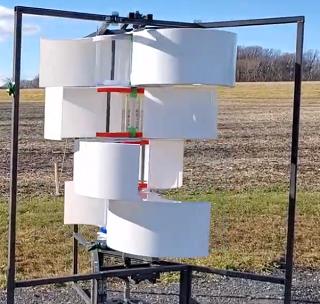Harmony Vertical Axis Wind Turbine

From the pic above (taken from the video), let’s say that the area swept by this device is about 1.5 meters², which we’ll convert to that of a circle with radius 0.7 meters. Recall that the power consumption of the average American house is about 5000 Watts. Let’s plug all this into our friendly wind power calculator, which uses the equation: Power = π/2 * radius² * wind velocity³ * air density * efficiency–and find that we’d need an average wind speed (blowing 24 hours per day) of 53.3 MPH.
The company claims this device is much more efficient than its horizontal axis counterparts. The problem there is that today’s wind turbines already extract 80 – 90% of the theoretically available energy from the wind, so this is simply false.
The company says it will be opening a crowdfunding site soon. Anyone who thinks that rooftops experience a constant wind speed of 53 MPH should jump right on it. Others should proceed with caution.

This is a piece of crap. Vertical axis turbines are inherently less efficient than horizontal, and that kind of high solidity design will have high drag and operate at very low speed with high torque. Mounted on a roof, I would say this thing will generate almost nothing most of the time, and on the rare occasion it operates with decent output, will risk serious damage to the roof.
Rooftops inherently have high turbulence due to disturbed wind patterns with all sorts of odd vortices and are really not good locations for wind power.
This is a terrible design for the proposed application, but might just about work directly driving a water pump on a windy plane.
All told, virtually all potential users could put up a few solar panels and make a solid and reliable contribution to their electricity usage at far lower cost per kWh.